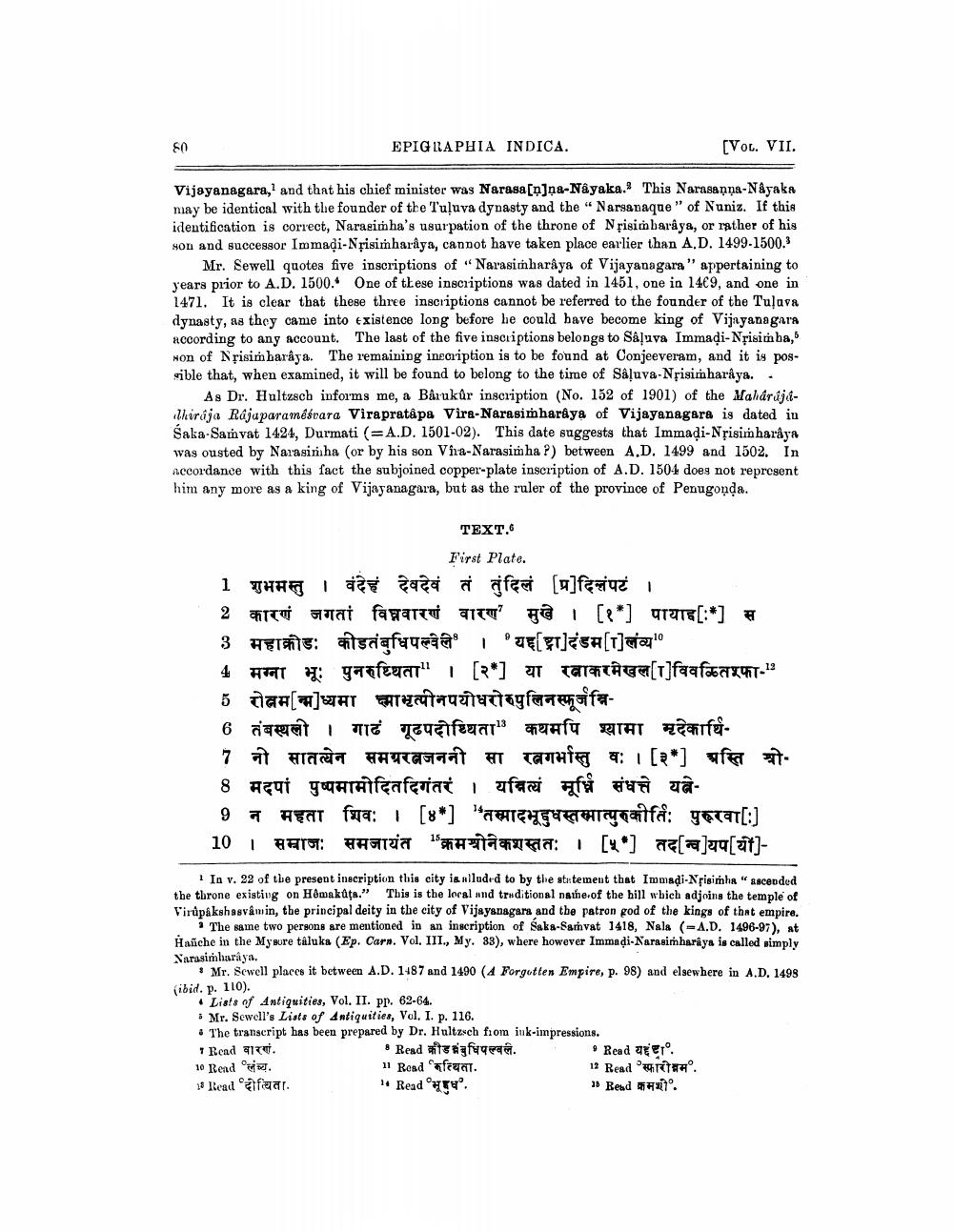________________
60
EPIGRAPHIA INDICA.
[Vol. VII.
Vijayanagara,land that his chief minister was Narasa[n]na-Nayaka. This Narasanna-Nayaka mmay be identical with the founder of the Tuluvadynasty and the "Narsanaque" of Nuniz. If this identification is correct, Narasimha's usurpation of the throne of N fisit baraya, or rather of his son and successor Immadi-Nrisimharaya, cannot have taken place earlier than A.D. 1499.1500.3
Mr. Sewell quotes five inscriptions of Narasimharaya of Vijayanagara" appertaining to years prior to A.D. 1500. One of these inscriptions was dated in 1451, one in 14€9, and one in 1471. It is clear that these three inscriptions cannot be referred to the founder of the Tulava dynasty, as they came into existence long before he could have become king of Vijayanagara according to any account. The last of the five inscriptions belongs to Såļuva Immadi-Nrisimba, Hon of Nộisim baraya. The remaining inea-iption is to be found at Conjeeveram, and it is posgible that, when examined, it will be found to belong to the time of Såļuva-Nrisimharaya..
As Dr. Hultzsch informs me, a Barukür inscription (No. 152 of 1901) of the Maharajathiraja Rajaparamêsvara Virapratâpa Vira-Narasimharaya of Vijayanagara is dated in Saka-Samvat 1424, Durmati (=A.D. 1501-02). This date suggests that Immadi-Nrisimharaya was ousted by Narasiniha (or by his son Viha-Narasimha?) between A.D. 1499 and 1502. In Accordance with this fact the subjoined copper-plate inscription of A.D. 1504 does not represent him any more as a king of Vijayanagara, but as the ruler of the province of Penugonda.
TEXT.6
First Plate. शुभमस्तु । वंदेहं देवदेवं तं तुंदिलं [प्र]दिलंपट । 2 कारणं जगतां विघ्नवारणं वारण' मुखे । [१] पायाह[:*] स 3 महाकोड: कीडतंबुधिपल्वेले । यह[ष्ट्रा]दंडम[7] लव्य" 4 मग्ना भूः पुनरुध्थिता" । [२] या रवाकरमेखल[7] विवकितरफा-12 5 रोनमन्मध्यमा क्ष्माभृत्पीनपयोधरोरुपुलिनस्फूर्जनि6 तंबस्थली । गाढं गूढपदोथ्थिता कथमपि श्यामा मृदेकार्थि7 नी सातत्वेन समग्ररत्नजननी सा रत्नगर्भास्तु वः । [३*] अस्ति श्रो. 8 मदपां पुष्पमामोदितदिगंतरं । यनित्यं मूर्ध्नि संधत्ते यत्ने9 न महता शिवः । [४*] "तस्मादभूदुधस्तस्मात्पुरुकीर्तिः पुरूरवा[:] 10 । समाजः समजायंत क्रमश्रोनेकशस्ततः । [५] तदन्चियपयों]
I Inv.22 of the present inscription this city ianlluded to by the statement that Immadi-Nrisimha fascended the throne existing on HOmakata." This is the local and truditional nathe of the hill which adjoins the temple of Virupakshasvâmin, the principal deity in the city of Vijayanagara and the patron god of the kings of that empire.
. The same two persons are mentioned in an inscription of Saka-Samvat 1418, Nala (=A.D. 1496-97), at Haliche in the Mysore taluka (Ep. Carn. Vol. III, My.33), where however Immadi-Narasimharaya is called simply Narasimharaya.
* Mr. Sewell places it between A.D. 1487 and 1490 (4 Forgotten Empire, p. 98) and elsewhere in A.D. 1498 (ibid. p. 110).
Lists of Antiquities, Vol. II. pr. 62-64. • Mr. Sewell's Lists of Antiquities, Vol. I. p. 116. . The transcript has been prepared by Dr. Hultzsch from ink-impressions. T Read वारणं. B Read क्रीडबुधिपल्वले.
• Read यदा. 10 Read 'लंच. 1 Road 'भत्थिता.
1- Read 'स्फारीबम. is Read 'दोस्थिता. - Read भूध'.
W Read कमशी.




